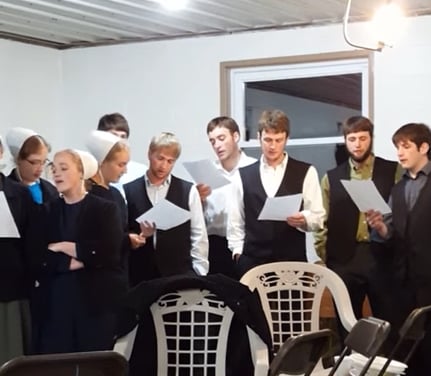Amish Christmas
Christmas is one of many holidays observed by Amish, and with an expected emphasis on family rather than Santa. Amish-raised scholar John Hostetler shares in Amish Society that some Amish children may be “exposed to such customs [ie, Santa and the Christmas tree] if they attend public school, and some Amish parents come to the annual parochial school Christmas program. Some Amish have adopted the practice of drawing names among themselves for buying presents.”
Hostetler, who grew up in Iowa and Pennsylvania, explains that “on Christmas Eve in my home, each child set a dish at his place at the table. Our parents filled the dishes with many kinds of candy and nuts after we were asleep.”
Amish do give gifts at Christmas, and Hostetler notes that “children who want a specific toy usually get it, but toys are generally simple and inexpensive.” While selling books in Amish communities, I can remember a number of instances when sets were tucked away by forward-looking parents as a Christmas surprise for the children.
Hostetler goes on to explain that “married couples may buy surprises for each other, usually something they need, such as a new bed or a chair. Girls may receive decorative dishes from their parents. Gifts are frequently left on display in the sitting room until after New Year’s Day.”
On the matter of giving gifts, I often get questions on what types of gift are suitable, with the giver ofter concerned about potentially offending the receiver by a poorly-chosen gift.
As a rule, and as Hostetler’s description above indicates, gifts that have some function will likely be better-received by Amish than those that don’t. Simple toys for children are generally fine as well, and Amish-run dry goods shops often have an array of games and other basic toys for children.
There is as usual variety among the Amish. My mother usually likes to send baked goods along with me when I travel to visit friends in Pennsylvania (baked goods and most consumables for that matter, will never lead you astray). I know she has given small games and if I recall even a book or two for the younger children.
Once she wished to send a bottle of North Carolina wine along, which I vetoed as I could not recall whether wine was kosher in the family or not. As it turned out, it probably would have been a safe bet, as she later helpfully reminded me that we had even been offered some homemade wine by the family head himself on one visit. (here is a previous post on the Amish and alcohol).
And, best wishes to everyone this Christmas!






What a great post about Christmas! I have a semi-off-topic question…I know most children attend the one-room schoolhouses, but where do they attend public school? Is there more that attend public school in the smaller communities or are there certain states that have a higher percentage of those attending, or do you even know? I hope you have a great time at grandma’s for Christmas and a day well spent with family!!
Where do Amish children attend public school?
Hi Beth, a great question, and actually close to topic. The most ready example of Amish children attending public school are thesettelments at Holmes County, OH, and also the Elkhart/Lagrange County settlement in N. Indiana.
You definitely still have a large majority of Amish children in Amish parochial schools in these settlements, but there is a significant segment that do attend area public schools. To my knowledge, Lancaster on the other hand, has few to no Amish children in public schools.
I am not able to say definitively about other settlements. Perhaps other readers in the know can comment on that. I would imagine that Nappanee, for instance, probably has some public school attendance as well. Not sure about Geauga County, OH, and settlements such as Adams Co. and Allen Co. IN, I am doubtful. Karen Johnson-Weiner’s book ‘Train Up a Child” on Old Order schoolinglikely covers this but unortunately don’t have it in front of me.
A Merry Christmas to you Erik, and to all who visit your blog!
Hello,
On the public school option, when I lived in Holmes County, there were several of the grade schools that were pretty well Amish-only public schools. I can think of at least 4 that were pretty well 100% Amish students, but were actually public schools. The little school in Charm is an example. The school board there seems to have worked closely with the Amish population to dedicate those schools to the Amish and respect their beliefs as much as possible. (I am thinking that, for example, any teaching about evolution was kind of silently passed over, even though the teachers were non-Amish.) Of course, the area surrounding these schools is probably close to 80-90% Amish anyways. I think (not sure on this) that the few non-Amish students were bussed elsewhere. Mike
Merry Christmass to you and yours Erik and thanks for posting on the topic of Christmass.
I just love the picture of the horse drawn sleigh…i bet they are sooo cold.
Have a wonderful New Year and keep up the good work.
Buck Kidd
Thanks for the wishes everyone, I had a good one!
And Mike thanks for elaborating here. It’s my understanding that due to the high Amish composition of these schools they are in some ways run as ‘default’ Amish institutions, with teachers as you describe accommodating Amish ways.
Here in Centreville, MI, there are a dozen or so Amish students at the elementary school, probably those who are too far out to bike to the Amish school. The neighboring school district, Nottawa, is about half English, half Amish. To give an idea of size, Centreville has several classrooms of each grade, Nottawa has one classroom of each grade and the local Amish school has one or two rooms with about 50 students (guessing from size of building and number of bikes).
VA schools
The groups in Virginia, as well as the ones I know about in Minnesota, do not send their children to public schools. I remember when the school building was being built in the Whitegate community in VA, and all families had to come up with $$ to help build it. No matter the size of the family, every family pitched in the same amount (around $600 if I remember correctly). Of course, that was just for building materials (they provided the labor as you can imagine) and it was a great facility, with two floors, large separate bathrooms (with plumbing!) and handicapped access. It was used as a community and worship meeting place as well.
Merry Christmas
Erik, thanks for a great post. Wishing you a very Merry Christmas as you celebrate Polish style 🙂 Blessings in the New Year.
Merry Christmas
Eric,
Merry Christmas and thank you for all of your informative and sensitive posts.
Thanks Iain, I appreciate you reading and sharing here. Merry Christmas.
Nativity scenes
I have been trying to find out if the Amish make or display a Nativity scene in their homes at Christmas time. The information I’ve found on researching the subject is vague and contradictory. I understand that practices may very greatly between communities. I have heard that they do, but that seems at odds with their objection to graven images. Thanks for the help.
Pat
Christmas Traditions & Memories
Some of us have Amish and /or Amish Mennonite ancestors, and I’m wondering about Christmas traditions or memories.
My Dad was of that background and one fond memory is his struggle about having a Christmas tree. He’d put it off as long as possible, sometimes not getting one at all. One year in Colorado some of us children could see he probably wasn’t going to, so we took two tumbleweeds and put them together and made our own, spraying it with fake snow. I struggled with it at times when I had my own family too. I’m glad I can see and respect both viewpoints, but mostly I’m grateful for the love in this memory.